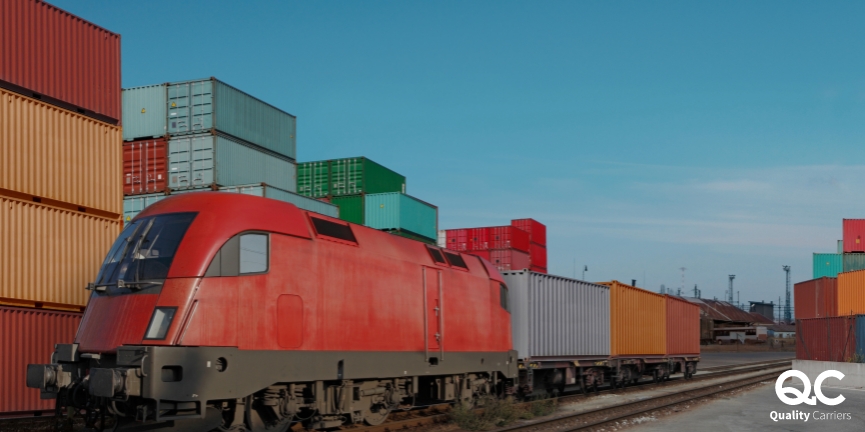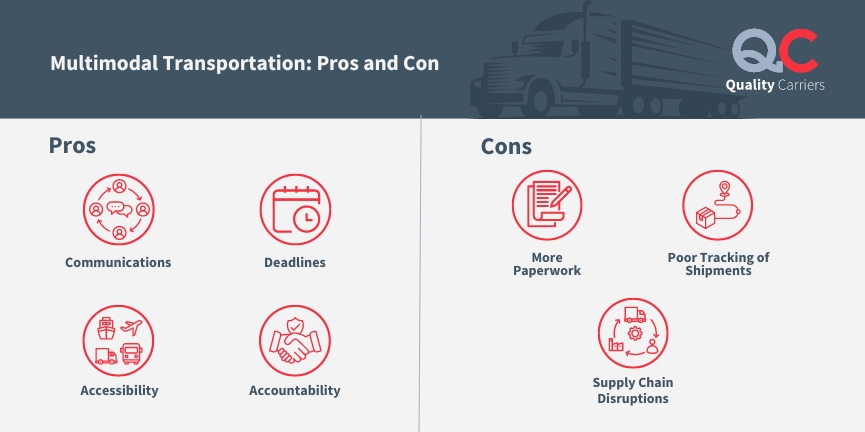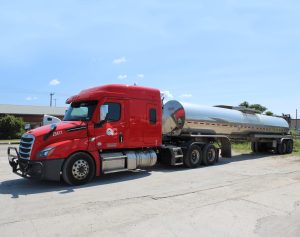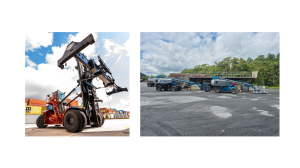Multimodal transportation has become increasingly essential as globalization and international trade expand, driving the need for more efficient and seamless transportation methods. This involves using multiple forms of transportation to transport goods across long distances.
In this blog, we will explore multimodal transportation, how it differs from intermodal transport, and its benefits and challenges to the trucking and logistics industries.
What is Multimodal Transportation?
Multimodal transportation refers to using two or more modes of transportation under a single contract or bill of lading to move goods from one point to another. This allows for easy transitions between different modes of transport without the need for separate contracts for each segment. Multimodal transport is often used in international shipping, where goods must travel across multiple regions and countries using different transportation methods.
The critical advantage of multimodal transportation is that it provides a single point of accountability, meaning one carrier is responsible for the entire shipment, even though multiple modes are used. This simplifies logistics, improves coordination, and reduces potential delays.
Intermodal vs. Multimodal Transport
While intermodal and multimodal transportation involves multiple modes of transport, the primary difference lies in the contracts and management. In intermodal transportation, each journey segment is handled by different carriers, and separate contracts are required for each mode of transport. With multimodal transportation, only one contract and carrier oversee the entire process, making it more streamlined and cohesive.
In intermodal transport, goods are usually transported in standardized containers that remain intact as they move between modes (from a truck to a train). In contrast, multimodal transport does not necessarily require standardized containers, and the transfer of goods between modes may involve unloading and reloading.
Different Modes of Multimodal Transportation
1. Road Transportation
Road transportation is crucial in multimodal transport, serving as the primary means for picking up and delivering goods. Trucks and other road vehicles are essential for the first and last mile of transportation, making door-to-door deliveries possible. This flexibility allows trucks to access urban areas, rural locations, and regions without direct connections to rail, ports, or airports. In addition to accessibility, road transport offers a high degree of flexibility in route planning, making it ideal for short and medium distances. However, road transport can be impacted by traffic congestion, road conditions, and fuel costs, which may limit efficiency when used as a standalone mode for long distances.
2. Rail Transportation

Rail transportation is one of the efficient and cost-effective methods for moving large quantities of goods over long distances, especially for bulk commodities like coal, minerals, and agricultural products. Trains can carry large volumes of goods in a single trip, making them an eco-friendly option due to lower fuel consumption per ton than trucks. Rail transport is often used to connect major hubs, such as ports and inland terminals, allowing for the seamless transfer of containers between ships and trains.
Rail is ideal for heavy or bulky cargo, and its structured schedules make it a reliable option. However, rail networks are more flexible than road transport, as they are limited by fixed routes and schedules, making them less suitable for time-sensitive deliveries or remote locations.
3. Maritime Transportation
Maritime transportation is known as the backbone of international trade, accounting for the movement of more than 80% of global goods by volume. It is an efficient and cost-effective solution for transporting goods over long distances. Specialized vessels transport various goods, from manufactured products to raw materials. Maritime transport is particularly suitable for heavy, bulky, or non-perishable goods like automobiles, machinery, and raw commodities (e.g., oil, coal, grain). Although slower than air or rail transport, maritime shipping’s ability to carry massive quantities of cargo at lower costs makes it essential for global supply chains. Ports are critical hubs in multimodal networks, where goods can be transferred to trucks or trains for further distribution.
4. Air Transportation
Air transportation is the fastest mode of multimodal transport, making it ideal for urgent, time-sensitive shipments. It is commonly used for high-value, lightweight, or perishable goods like electronics, pharmaceuticals, and fresh produce. While air transport is significantly more expensive than other modes like sea or rail, it offers unparalleled speed, which is vital for businesses that need to meet tight deadlines or ship items that cannot withstand long transit times.
It is a key component of multimodal systems when goods must be moved quickly across long distances, such as from one continent to another. Airports serve as multimodal hubs, where goods are transferred to road transport for local delivery or other modes for onward transit. However, air cargo is limited in volume and weight capacity compared to maritime and rail transport, and weather conditions can sometimes disrupt schedules.
5. Intercontinental Transportation
Intercontinental transportation involves the movement of goods between continents. This combines different modes of transportation to achieve the most efficient and cost-effective solution. Most intercontinental shipments are handled by maritime transport, where goods are shipped across oceans to significant ports. From there, containers may be transferred to rail or trucks for distribution within the destination continent. Sometimes, air transport is used for faster delivery when the goods are high-value or time-sensitive. This requires careful coordination of various transport modes and logistics partners and compliance with international trade regulations, customs clearance, and security protocols. Multimodal networks are essential for ensuring smooth transitions between modes and minimizing delays in the global supply chain.
6. Pipelines
Pipeline is a primarily used to transport liquids and gases, such as crude oil, refined petroleum products, natural gas, and chemicals, over long distances. Pipelines provide a continuous, energy-efficient method for transporting large volumes of these materials across vast land areas, often over hundreds or thousands of miles. They are a vital part of the energy infrastructure, enabling the safe and cost-effective movement of raw materials from production sites to refineries, storage facilities, and distribution centers.
While pipelines are typically used for liquid and gas transport, they are essential to multimodal systems when integrated with other transport modes. For example, oil and gas products may be transported by pipeline to a port and loaded onto ships or trucks for final delivery. These are highly efficient and reduce the need for road and rail transport, but they require significant infrastructure investment and are limited to specific types of cargo.
Multimodal Transportation: Pros and Cons
Let’s explore the pros and cons of multimodal transportation to understand its impact on the logistics industry better.

Pros:
- Communication – With a single point of contact for the entire journey, communication is simplified. Shippers only need to deal with one carrier or logistics provider, ensuring streamlined coordination and fewer misunderstandings.
- Deadlines- Multimodal transport often results in better adherence to deadlines. Since the entire process is handled by one company, the carrier manages transitions between transport modes, reducing delays and improving reliability.
- Accessibility – Multimodal transportation offers greater flexibility and access to a broader range of transport options, ensuring that goods can reach almost any destination, even in remote areas.
- Accountability – Since one carrier is responsible for the entire journey, accountability is evident. If any issues arise during the transport process, the airline must address them and simplify dispute resolution and claims.
Cons:
- More Paperwork – Although multimodal transport simplifies coordination, it often involves more paperwork, as each mode of transportation may have its own regulatory requirements, documentation, and customs clearance.
- Poor Tracking of Shipments – Tracking shipments in real-time can be more difficult in multimodal transportation, especially if there are delays or breakdowns during the transfer of goods between modes. Without proper tracking systems in place, it may be challenging to maintain visibility throughout the journey
- Supply Chain Disruptions – Disruptions at any journey stage, such as port congestion, bad weather, or labor strikes, can lead to delays that affect the entire supply chain. Multimodal transportation relies on the smooth coordination of various modes, so disruptions in one area can have ripple effects.
The Importance of Multimodal Transport in the Trucking Industry
Multimodal transportation plays a critical role in the trucking industry by allowing for the efficient movement of goods across long distances, domestically and internationally. It enables trucking companies to provide a comprehensive logistics service integrating road transport with rail, sea, and air options. This enhances the industry’s ability to meet the diverse needs of customers, from small local shipments to large-scale international freight operations.
By combining different transportation modes, trucking companies can optimize routes, reduce costs, and deliver goods more efficiently. Multimodal transport also helps the industry remain competitive in an increasingly globalized market by offering customers greater flexibility and access to remote locations that would be challenging to reach by truck alone.
Conclusion
Multimodal transportation offers a flexible and efficient way to move goods. It leverages the strengths of various transport modes to ensure reliability and cost savings. While it comes with some challenges, the benefits far outweigh the drawbacks for businesses looking to streamline their logistics. For companies in the trucking industry, multimodal transport opens new opportunities to expand their operations and meet the growing demands of global trade.
FAQs
Multimodal transport is commonly used for a wide range of goods, including consumer products, machinery, raw materials, agricultural products, and high-value items that require timely delivery.
Multimodal transport benefits businesses by reducing costs, improving delivery times, offering greater flexibility, and simplifying communication and accountability with one logistics provider.
While multimodal transport can sometimes involve higher upfront costs due to the coordination between different modes, it often results in cost savings through reduced delays, better use of transport modes, and streamlined operations.




